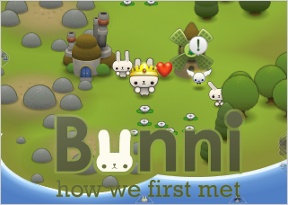
Provide them with any help or guidance they ask for, but don’t be afraid to let them fail. Holding employees accountable is a powerful way to build a sense of ownership, so set clear expectations about the results you want. Worse, it undermines their confidence that they can do the task, or at the very least that they can do it to their manager’s liking.
Working bunni how we first met how to#
Instead of developing a sense of independence and feeling like they “own” figuring out how to achieve what’s needed, employees learn to rely on you as a manager. Micromanaging erodes a sense of ownership. So don’t make assumptions about your team’s level of understanding, and take the time needed to give them the information they need. Unfortunately, we know from this IBM study that this isn’t clear for a lot of people (check out the findings below). This has to do with the goals and objectives you set, but also to job title and job description. It needs to be crystal clear how these objectives impact the company’s success. Otherwise, they’ll have no motivation to stick around at all – let alone to take ownership.Ī strong sense of ownership and engagement is more likely to occur when the work being done is aligned with objectives.


Millennial employees in particular derive purpose and feel more engaged when they understand how their work directly contributes to the organization’s success. It’s essential for employees to understand how their goals connect to the larger objectives of the organization. If someone spends significant time on a product, team or job, then a sense of ownership is likely to develop. Align work, goals and purposeġ7th-century philosopher John Locke first presented the idea that people feel ownership over their labor and the things that they produce or create. Consider adding it to your one-on-one meeting agendas at least once a year to keep your team in the know. As a manager, it’s definitely worth your time to make sure each person on your team understands the value of the program on a regular basis. Many employees that have stock awards, stock options or stock purchase plans don’t understand the program or the value. "Taking the time to understand each person's needs not only helps with productivity, but over time also builds the sense that this is the right team for them." Click To TweetĪccording to the National Bureau of Economic Research, companies with employee ownership “tend on average to match or exceed the performance of other similar firms.”Įven if you, as a manager, have zero control over your company’s ownership program, there’s still something important you can do for your team: make sure they understand it. Taking the time to understand each person’s needs not only helps with productivity, but over time also builds the sense that this is the right team for them. A simple example: If you have a single mother on your team, how are her needs different? What can you do to make her work and her life fit together better?Įveryone has unique circumstances. One of Ciara’s suggestions is to try to understand what diversity means to your team – and then do something about it. “When you build a culture where people can be their authentic selves, they’re going to bring their best work, their best ideas and their best people to your company.”

Ciara Trinidad, Head of Diversity, Inclusion and Belonging at Blend put it best in an interview with First Round Review: When employees feel like they fit in, they’re more likely to personally identify with their work. Here are five strategies to help your employees take ownership of their work: 1. You can create shared agendas, summarize decisions and assign action items, all from one place! Have you introduced your team to Hypercontext yet?
Working bunni how we first met free#
How do we change that? How do you help your team internalize the need to do a task, and, in turn, encourage them to truly do their best? We have a few strategies for you to try.įirst thing’s first: our free meeting agenda app makes it easy for your team to take ownership of their work. In other words, they’re not taking ownership of their work. Unfortunately, according to the American Management Association, on average, a quarter of employees avoid this responsibility. Someone with a strong sense of ownership would say, “I need to do this task, I can do it, and I, therefore, own the responsibility for achieving success.” It’s the opposite of passing the buck or making excuses.

At work, we take ownership when we assume responsibility over a target or result. The term ownership comes from a concept called psychological ownership, which means we can feel like we “own” something even if it’s not a physical object.


 0 kommentar(er)
0 kommentar(er)
